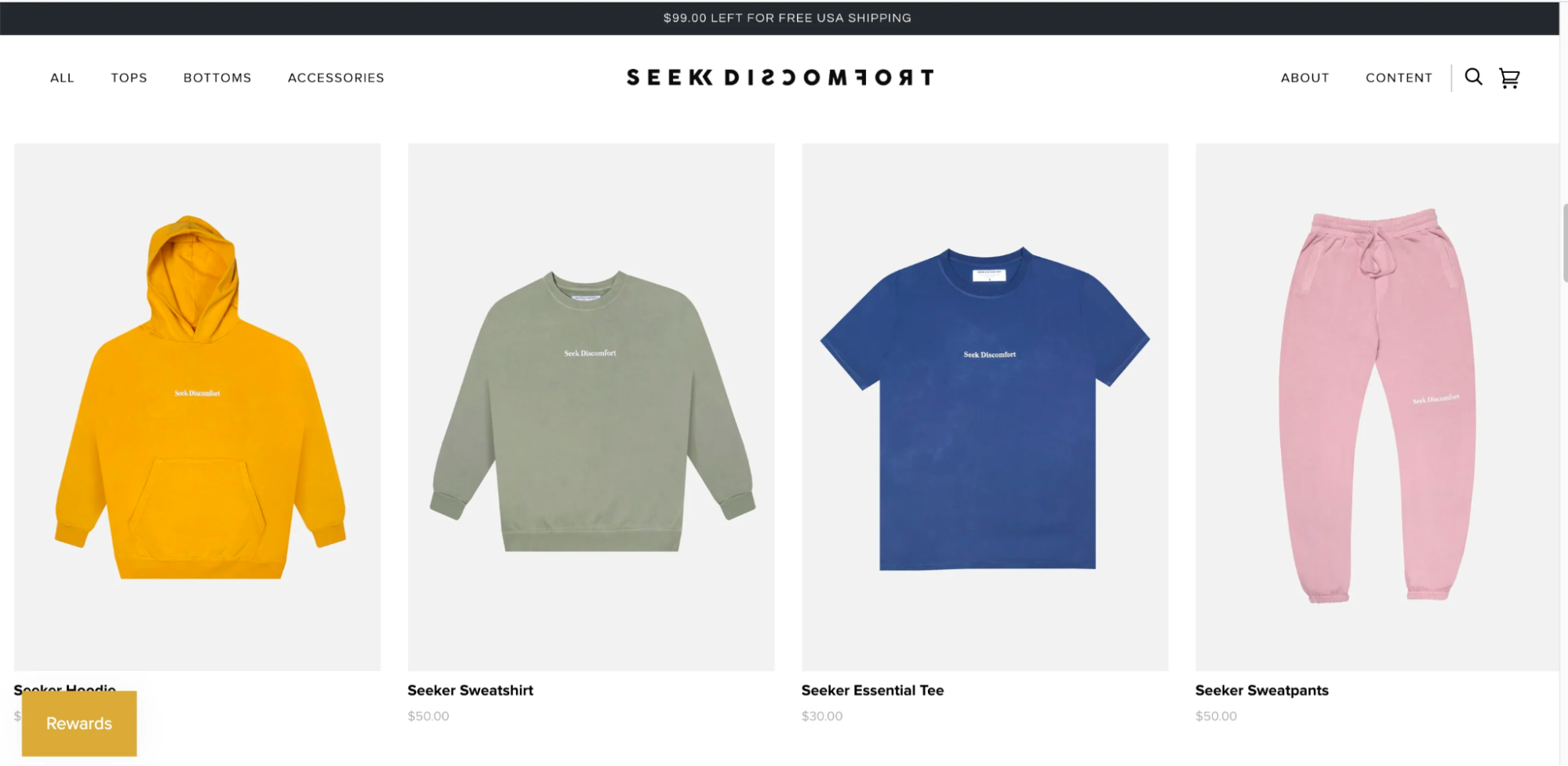How to create and sell merchandise for your fans
We’ll show you how to successfully execute your own product strategy, from coming up with product ideas to selling directly to your fans. You’ve launched your brand and built a loyal fan base. Now you want to create and sell your products. So how do you do that?
Merchandise like T-shirts, plush toys, phone cases, custom socks, and sweatshirts are more than just products. They are a vital way for businesses to create new revenue streams by turning customers into brand advocates. The industry has grown significantly over the past decade, establishing itself as a powerful tool for brands to connect with their fans and diversify their revenue streams.
In the next step, learn why and how to create and sell merchandise. With insights and advice from Jack Honarvar, co-founder of Fan of a Fan , you’ll learn how to use merchandise to take fan engagement to the next level. This will go beyond just selling, and help you build deeper connections with your fans and build brand loyalty.
Why do people buy products?
Merchandise helps fans feel connected to the values your brand embodies and to others in your community.
You can create opportunities like:
- Build more meaningful relationships with your fans
- Delight and grow your fans with free stuff
- Launch products in collaboration with other creators and brands
- Encourage fans to post content wearing your products
- Create free word-of-mouth advertising
For example, fans of Yes Theory shared stories of wearing gear from the YouTuber's sub-brand Seek Discomfort to their first day at a new job. Another fan even wore gear from the brand to the birth of her first child because of the positivity and personal growth it embodies.
“One of our fans told me that their flight had been canceled and they had to wait hours for their next flight,” says Zack. “They saw someone in the airport waiting room wearing a Seek Discomfort hoodie. While stranded at the airport, the two strangers became good friends because they were both fans of the same market.”
While diehard fans might pull out their wallets to buy a T-shirt with your logo on it, Zack says the most meaningful merchandise has the potential to reach new audiences beyond your fan base. Whether you’re creating merchandise for your TikTok channel or your Twitch followers, there’s clearly a lot of potential in branded merchandise.
Developing a product strategy
The products can be varied: they can be a recurring revenue stream for your store, they can facilitate collaborations with other brands, or they can simply be freebies for your customers.
One of the biggest decisions in product strategy is whether to sell beneath an existing brand or launch as a sub-brand (e.g. Seek Discomfort by Yes Theory).
1. Selling products under a sub-brand
Sub-brands typically retain the characteristics of the parent brand (color palette, messaging, imagery, etc.), but have their own logo, products, and services.
“The beauty of this approach is that it allows you to grow new audiences beyond your existing customer base,” says Zack. Sub-brands can also facilitate collaborations or co-branding.
2. Selling products under existing brands
For Atticus the Poet, it made sense to leverage his name as a writer to run an e-commerce website where fans could find his books, t-shirts, hats, jewelry, and his own brand of wine.
“Atticus has a merchandise-centric clothing line,” Zack says. “But he also has a line outside of the ‘Atticus’ brand called ‘Lost Poet Wine’ that he sells in stores and online.”
Atticus also sells directly on Facebook and Instagram through his Shopify store.
No matter which approach you choose, building a great product ultimately comes down to trusting your gut. “Make something you’re proud of, something you want to stand behind, something you actually want to use or wear,” Zack adds.
How to create a product in 4 steps
Creating a product can be as simple as putting your logo on a t-shirt or hat. But there is a simple process to producing a fresh merchandise concept that resonates with fans and potential new customers:
- Defining your brand identity
- Brainstorm product ideas and validate them with your audience.
- Product Design and Simulation
- Choose a Print on Demand Partner or Find a Manufacturer
1. Define your brand identity
Let’s take Shopify as an example to show you how to go from idea to prototype. Shopify is a platform that gives millions of entrepreneurs the tools they need to start and grow their ecommerce businesses. The Shopify brand stands for independence, resilience, creativity, and of course, business.
Consider your brand identity and differences. This will help you narrow down the aesthetic and the type of product you want to create. Use this information to start the product creation process.
2. Brainstorm product ideas and test them with your audience.
You’ve spent years building a brand that resonates with your customers. Now, why not ask them what kind of products they want to buy?
“One thing I always recommend is for creators or brands to ask their audience what they want, or give them a choice between several options. They can ask through Instagram Stories, email, the community, or text messages. ‘Do you prefer hats, board games, t-shirts, or hoodies?’” says Zack.
Asking your audience for feedback makes them feel like they are part of the process, which increases their satisfaction and engagement with the final product.
So we asked our audience on X (formerly Twitter) what Shopify products they would like to see.
Based on the feedback we received, we prototyped the following product ideas:
- Shopify Bag Logo T-Shirt/Crewneck/Hoodie. The Shopify Bag is our iconic logo mark and is a great design to give to your fans.
- Minding My Business Dad Hat. A witty slogan that entrepreneurs often put on their hats to describe how absorbed they are in their business.
- Cha-ching Hoodie. “Cha-ching” is the sound you make when you make a new sale on Shopify. Imagine how that would sound on a hoodie.
- Independent Crewneck. Independence is a powerful word that defines many of the people who run their businesses using Shopify. It’s a powerful expression that connects to our brand.
- Shop Small, Think Big Tote Bag. The perfect tote bag to carry while shopping at independent businesses in your community.
- “Ask Me About My Business” t-shirts. A simple way for independent business owners to share their identity with others.
- Shoppy Hoodie. Shoppy is the unofficial Shopify mascot created during a company hack event years ago.
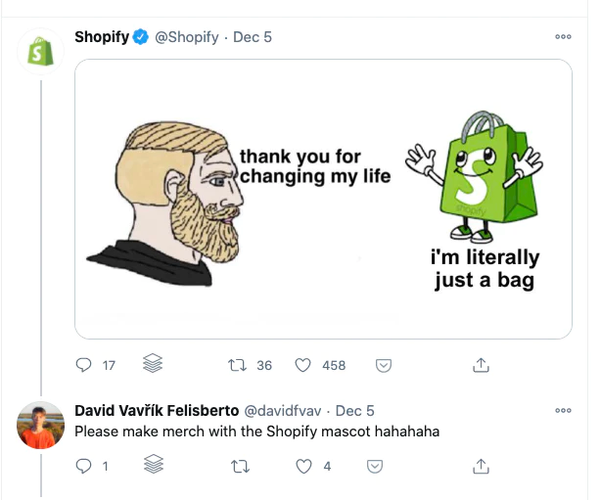
3. Product Design and Demo
While most product companies offer design services, Zack recommends owning the design process as much as possible. “You’ll understand the brand much better than someone who’s new to it, so it can be better to find the design yourself,” Zack says. You can hire a product designer on Upwork or use your network to find one, but keep these tips in mind:
- Provide context : Provide some background on the type of product you’re choosing and the audience you’re targeting, and share any brand guidelines you have. This will help designers come up with designs that fit your brand.
- Clear Description : Be specific about what you want your design to be. Provide specific feedback during design reviews and share as much detail as possible so the designer can work in the right direction. It is recommended to go through at least one or two review cycles.
- Create a mood board : Gather inspiration, examples, and references to create a mood board for your designer to start with. A mood board can help clarify the direction and style of your design.
Many print-on-demand companies provide mockup generators to help you visualize your products. For example, design tools like Placeit allow you to create lifestyle mockups of your products and share them with your customers. Just as you ask your customers for product ideas, you can also get feedback on your designs. This allows you to make sure your customers feel involved and that you are on the right track.
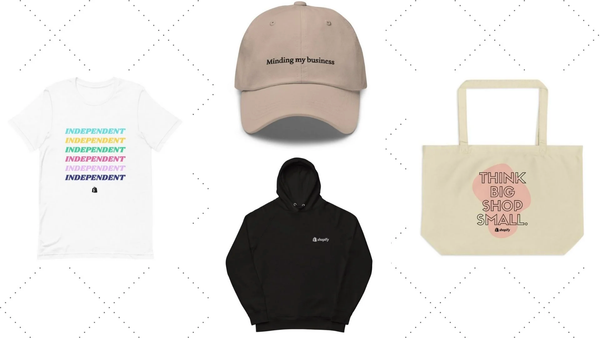
4. Choose a print-on-demand partner or find a manufacturer
After you receive feedback, you can start thinking about how to build your product. There are two popular options:
- Print on Demand : Work with a print on demand partner to automate manufacturing and delivery.
- Manufacture from Scratch : You can find a manufacturer to make a specific product, contract them to produce it, and either hold inventory and sell it yourself or have a third party ship it to you.
Let's take a closer look at each approach.
Services for making products
Print on demand is a low-cost, low-risk, easy to set up and manage method. However, depending on the service you choose, your product and customization options may be limited. On the other hand, manufacturing from scratch offers more options and flexibility to create exactly what you want, but can be more expensive to produce.
Use print-on-demand services
Most print-on-demand services are free to get started (you only pay for products when customers order them), and each service has a different product catalog. You’ll typically find basic clothing and accessories, like t-shirts, hoodies, sweatpants, and phone cases.
It is always important to order a sample before you start selling to ensure quality, as the colors you see on screen may differ from the colors you see in real life. If you are unsure, you can contact Print on Demand Customer Support.
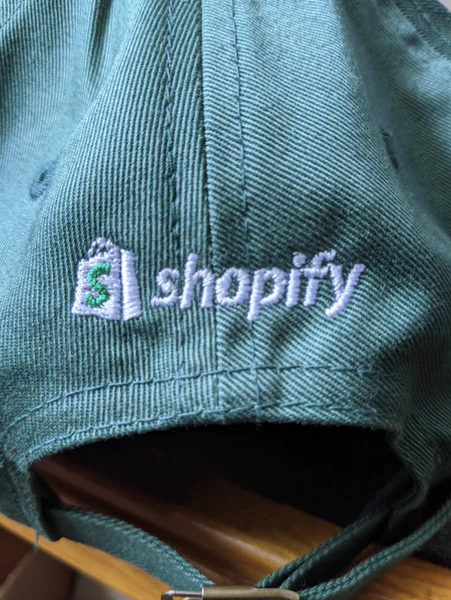
Find a manufacturer
If you’re not interested in making and selling your own handmade items, you can find a manufacturer to make your products. Shopify Capital can help you get funding to cover the costs of manufacturing. Compared to print-on-demand, manufacturing allows you to be more creative in how you design your products. For example, you can create a uniquely designed hoodie or create your own board game.
It’s a good idea to do some market research before working with multiple production companies. Companies like Fan of a Fan create merchandise for creators and brands, but it’s a good idea to compare multiple options to find the best partner for you.
Here are some things to keep in mind before entering into a merchandise contract:
- Intellectual Property Ownership. Make sure you own the IP of your brand, your clothing designs, and anything new created through your partnership. It’s important to retain the rights in case your relationship with your partner ends.
- Compensation structure. Check if it is a fixed fee or variable based on profit sharing. When working with a product manufacturing company, a profit sharing model is most common and can range from 15% to 50% of revenue.
- Contract term. Zack advises against long-term contracts. Set a grace period (e.g., three months or one product launch). During this period, evaluate whether the partner meets deadlines, produces quality products, responds to emails promptly, and is generally reliable. After this trial period, you can decide whether to continue working with the partner.
- Hidden Costs. Review all costs that may arise from the beginning of the product launch to the end. For example, warehouse costs, packing and sorting fees, shipping costs, design costs, website management, customer service costs, etc. Be careful not to have any unexpected hidden costs after you sign a revenue share agreement.
How to sell products
Marketing a product is a little different than marketing a traditional product. You sell to your existing fans first, and then to new customers second. This means that you already have a guaranteed audience of potential customers.
Here are some marketing methods you can use to sell your products:
Word of mouth
A great product is marketing in and of itself. If your fans buy your product and wear it often, people are more likely to ask about it.
But the product must be high quality. “Selling merchandise is like giving your fans a chance to promote your brand,” says Zack. “But if you make a low-quality product, your fans will only wear it once or twice.”
The more often someone wears your product or takes it out to show others how great it is, the more exposure your brand gets, which naturally leads to more word of mouth. Create a product that is worth bragging about and create more buzz.
Seek Discomfort is known for its high-quality products, which is why you can see many celebrities and athletes, like top tennis player Stefanos Tsitsipas, wearing their products in person or on social media.
Integrate products into your content
Content is another opportunity to promote your product naturally. This could mean wearing the product in a video, promoting it directly in a social media post, or incorporating the product into the creative concept of your content (e.g., a contest prize).
When you build a store for your products on Shopify, it becomes easier to sell your products within your content. Here’s how you can explore the different channels and approaches your customers engage with:
- TikTok : We work with TikTok creators to create content that can be used as merchandise.
- Instagram : Tag products in your posts and stories, and set up your own Instagram Shop on your profile.
- YouTube : Share product links in your video description or cards, and add a call to action (CTA) at the end of your video.
-
Buy Button : If you have a separate website or blog, you can embed your products or collections there.
You can also use a “link in bio” tool like Linkpop to create landing pages that link your social media followers to the products and other content you sell online.
How you best connect your content and products is up to you, after all, they are your customers.
Remarket to your existing audience
Retargeting allows you to promote your ads to your existing audience based on certain criteria, such as whether they follow you on Instagram or have already made a purchase.
Many advertising platforms (Google, Facebook, YouTube, TikTok, Snapchat) allow you to run retargeting ads by installing an advertising pixel on your website. If you have built an email list, this is also a great way to promote your products.
“That’s where you can get really high engagement and ROI,” says Zack. “On the other hand, new people are not going to buy anything, most of the time. That’s where you should focus your paid advertising.”

Preorder
One way to build anticipation for a new product is through a pre-sale campaign. Pre-sales give customers the opportunity to purchase a product before it is released, ensuring they receive it first when it is released.
What’s the advantage? You can gauge demand before investing in inventory, and you can even create a sense of scarcity or urgency to encourage fans to buy early.
“We made a few garment samples, took pictures, and didn’t keep any inventory. Then we opened the site for 72 hours, sold for 72 hours, and then closed the site. After that, we communicated our production progress via email.”
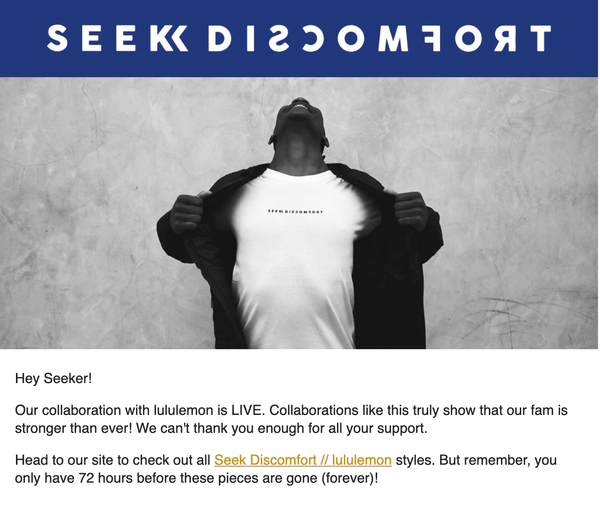
The Shopify App Store has a variety of pre-order apps that can help you run your presale. You can also use crowdfunding sites like Kickstarter to run your presale.
Creating products that fans love
Merchandise is worth starting for many reasons beyond generating additional revenue. It allows fans to connect with your brand, gives them a chance to express their passions, and makes them feel like they’re part of something bigger.
This is a business idea that allows you to be creative in new ways beyond the content or product that initially attracted your fans. Again, ask your customers and conduct a survey about possible designs.
If selling products is your first step into ecommerce, Shopify is one of the fastest and easiest ways to get started. Set up a store on social media to turn your followers into customers.
Ready to start building and selling products? Shopify has a variety of resources to help you, from funding to product sourcing guides. Start your free trial and explore all of our tools and services.
How to Create a Product FAQ
Can you make money selling products?
Yes, you can make money by selling merchandise. Many businesses make money by selling a variety of merchandise, including t-shirts, hats, and mugs. Selling merchandise can be a great way to supplement your business’s revenue, and it can even become your main source of income.
Does it cost money to make a product?
You can start making products with a low initial cost. If you have the skills to design, you can use free tools to simulate your designs and sell them on your online store for pre-order. Make sure to clearly inform buyers when the products will arrive, and place orders based on the number of units sold.
How do content creators create?
Many content creators create branded products through print-on-demand services using their own or secondary brands. Some content creators curate products or sell subscription boxes, while others partner with established brands or create and sell their own product lines.
What do I need to sell products online?
Creating and selling products online is easier than ever. Here are six ways to do it:
- Define your brand identity.
- Brainstorm product ideas and validate them with customers.
- Design your product and create mockups.
- Choose a print-on-demand partner or find a manufacturer.
- Add products to your store.
- Market your products to your fans.

